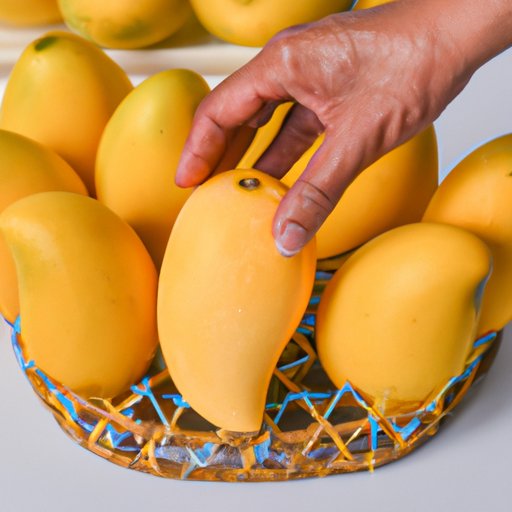
Introduction
If you’re an avid mango lover, you know that picking a perfectly ripe mango can be tricky. Often, you may end up bringing home an unripe or overripe mango, leading to disappointment when it’s time to indulge. But don’t fret! In this article, we will provide a comprehensive guide on how to tell when a mango is ripe and ready to eat.
5 Signs That Show Your Mango is Ripe: A Guide for Mango Lovers
One of the easiest ways to identify a ripe mango is by looking at its skin color. When a mango is fully ripe, its skin will have a bright, vibrant color and should be free from any blemishes or soft spots. Next, give the mango a gentle squeeze – the flesh should give in slightly when pressed. A ripe mango should also have a fruity, sweet fragrance and a smooth texture. Finally, pay attention to the stem – if it comes off easily, your mango is likely ready to be enjoyed.
How to Tell When a Mango is Ripe: Tips and Tricks
When selecting mangoes, there are a few more tips and tricks you can use to ensure you’re picking a ripe one. First, don’t rely solely on the skin color – some varieties of mangoes may have a green skin even when they’re ripe. Instead, feel for a slight softness when gently pressing the mango. Additionally, hold the mango up to your nose and take a deep breath – a ripe mango should have a strong, fruity aroma. Finally, if you’re purchasing your mango in a grocery store, check for the fruit’s ripeness by delicately plucking one up and sniffing the area near the stem.
One common mistake people make when selecting mangoes is assuming that a red blush on the skin means the fruit is ripe. While this can be true for some types of mangoes, it’s not always an accurate indicator of ripeness. Always rely on these five signs for the best results.
From Firm to Fragrant: Understanding Mango Ripeness
Mangoes go through multiple stages of ripeness before they’re ready to eat. When the mango is unripe, it will be hard and have a green hue. As it ripens, the fruit will become more yellow or red, and its texture will soften. A fully ripe mango will be fragrant, sweet, and juicy, making it easy to cut through and serve. Overripe mangoes will be mushy and have a sour odor, while underripe mangoes will taste sour and have a chalky texture. Understanding these stages can help you pick the perfect mango for your preferences.
The Sweet Spot: Identifying the Perfectly Ripe Mango
So, what is the “sweet spot” for mango ripeness? Well, it can vary depending on your taste preference. Some people enjoy mangoes when they’re at a more advanced stage of ripeness – these fruits will be softer, sweeter, and juicier. Others prefer to eat mangoes when they’re still slightly firm, with a tangy, citrus-like flavor. Determine your sweet spot by experimenting with different stages of ripeness and varieties of mangoes.
Mango Madness: Knowing When to Enjoy Your Fruit
Once you’ve picked the perfect mango, it’s time to dig in! There are plenty of ways to enjoy this tropical fruit, whether it’s in a smoothie, atop a salad, or simply peeled and sliced. For an easy snack, cut the mango into cubes and sprinkle with a pinch of chili powder and lime juice for a spicy kick. Alternatively, try your hand at making mango salsa, chutney, or even ice cream.
Conclusion
In conclusion, selecting the perfect mango is easier than you may think. By following these five signs of ripeness, as well as additional tips and tricks, you’ll be able to enjoy the tastiest, juiciest mangoes the next time you go shopping. Whether you eat them as a snack or as part of a recipe, mangoes are a delicious and healthy addition to any diet.




